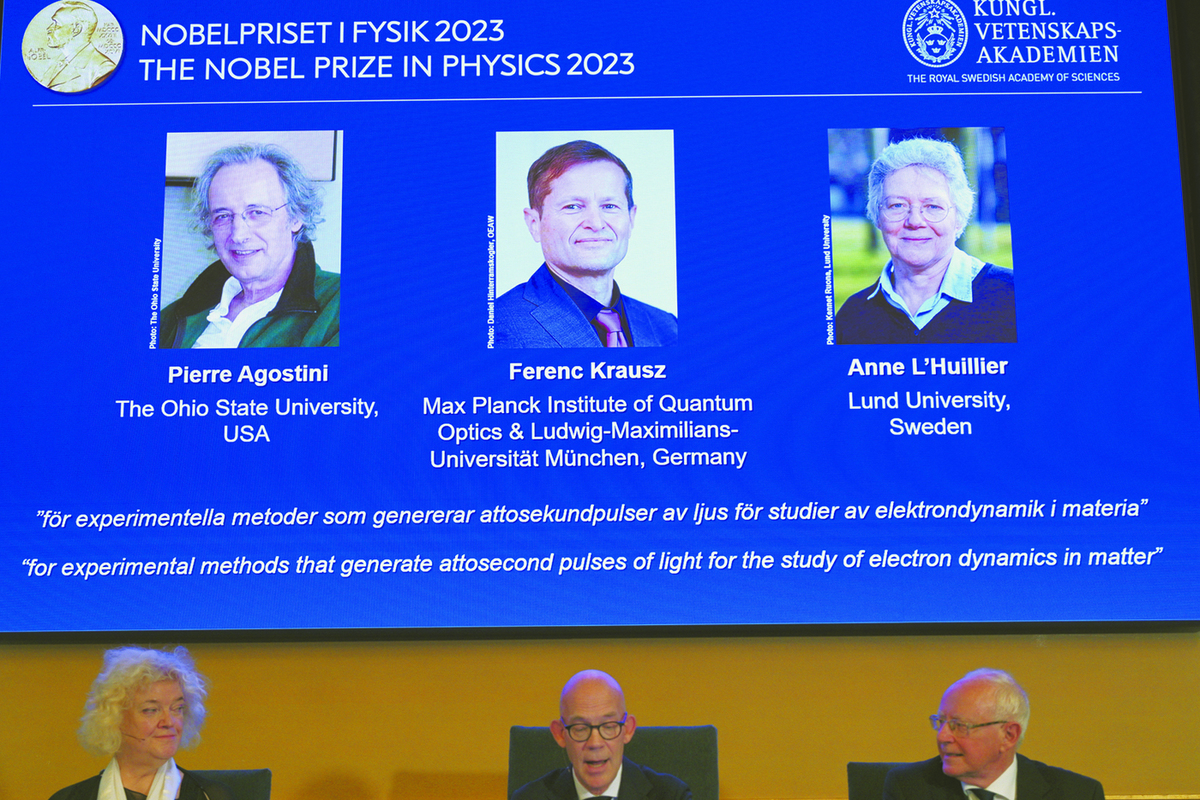See the electron: physicist Kolachevsky explained the essence of the discovery of the 2023 Nobel laureates
[ad_1]

The prize was awarded for the generation of extremely short pulses of light, thanks to which previously invisible electrons can be studied
The work of new Nobel laureates in physics – the American Pierre Agostini, the German Ferenc Kraus and the Swede Anne L’Hullier – will help establish control over processes that were previously impossible to track. The prize was awarded for the generation of extremely short, attosecond pulses of light, with which it will be possible to study the life of previously invisible electrons. Why these impulses can be useful, the MK correspondent found out in a conversation with the director of the Physics Institute. Lebedev RAS, corresponding member of the RAS Nikolai Kolachevsky.
Officially, the prize was awarded “for experimental methods for generating attosecond light pulses to study the dynamics of electrons in matter.” “These pulses are tools for exploring the world of electrons inside atoms and molecules,” the Nobel Committee said in an official statement. Previously, it was impossible to track them, but now formulas based solely on theory will “come to life”, and we will be able to see the electron shell of an atom with our own eyes. Through a microscope, of course.
“This is a well-deserved prize,” Nikolai Kolachevsky comments on the decision of the Nobel Committee. “The pioneers in this field who were able to overcome the femtosecond pulse, which was previously considered the shortest, were indeed awarded.
— Can you first tell us about femtosecond pulses?
— A femtosecond laser pulse has a length of 10 to the minus 15th power of a second (the name comes from the Latin word femten, meaning “fifteen”). Its length can also be expressed as a millionth of a billionth of a second. Previously it seemed that this was the limit. 1 femtosecond is equal to the period of vibration of light in a light wave; with its help, vibrations of molecules can be studied.
— What problems are they used to solve?
— Femtosecond pulses are real workhorses today. With their help, they monitor chemical processes, make holes in materials with very clean walls, carry out the most delicate surgical operations, and improve the GLONASS and GPS systems.
— When did the current Nobel laureates start working on generating shorter pulses?
– In the late 1990s – early 2000s, work began aimed at obtaining an attosecond pulse (from the Latin atten – “eighteen”) with a length of 10 to the minus 18th power of a second (or a billion billionth of a second. – Auto.). When Krause first demonstrated single attosecond pulses in 2001, there was already hope that he would be awarded the Nobel Prize for breaking the femtosecond pulse milestone. This is new knowledge in the world, the attosecond laser is one thousandth of a femtosecond.
– How can you imagine it?
“For example, one revolution of an electron around a hydrogen atom is thousands or hundreds of attoseconds.
Now we can watch his movement! Moreover, it is not only the dynamics of the electron that is of interest, but also the mechanism itself for generating a short pulse.
— Can you describe how a short laser pulse helps to see an electron?
— A femtosecond laser hits a target — a container (cuvette) with gas. An attosecond pulse is emitted from this gas target in the direction of the laser beam. This occurs not in the visible, but in the ultraviolet range. This ultrashort pulse can be isolated and directed at another target, for example, at a separate molecule or at a separate atom, and see how it interacts with this atom. Remember, back in school we were all shown drawings of the formula for a hydrogen molecule – a hydrogen atom, and an electron flying around it. So, to explain it very simply, an attosecond pulse, like a flashlight, illuminates this electron and knocks it out of the molecule. At the moment of knocking out, the direction in which it was moving before is registered. That is, registration destroys matter, creating beautiful photographs of a frozen electron cloud.
— Why can knowledge about electron dynamics be useful?
— So far, in a broad sense, there are no practical applications for the attosecond laser. This is purely fundamental science that should take off in the future. There is, in particular, hope for solving with its help the issues of quantum communications, the problem of emission of single photons, and quantum entanglement. Already today, channels with quantum encryption are being laid between banks… I think attosecond lasers will be primarily used in this direction. True, they will first need to create powerful laser installations, which are currently available in only ten institutes in the USA, Canada and Europe. Unfortunately, our country, which has a good priority in research with femtosecond lasers, is not yet working with attosecond lasers.
Newspaper headline:
If you don’t destroy it, you won’t see it
[ad_2]
Source link








